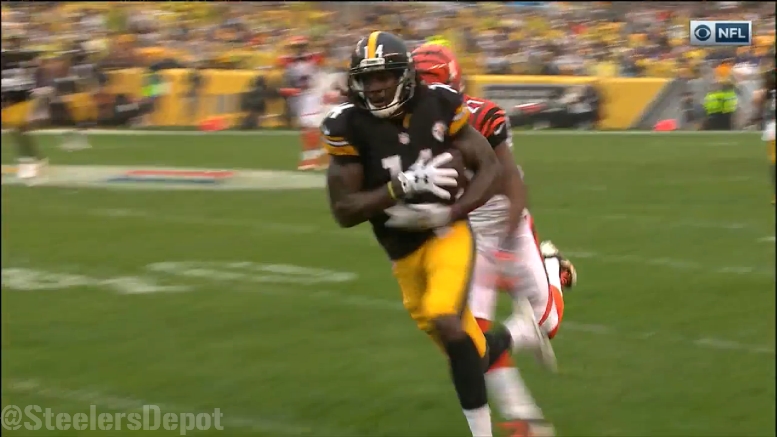As Alex Kozora mentioned yesterday, we have decided to turn our charting notes into a weekly series to make use of the data that we collect, and also, frankly, because we enjoy doing them, and we assume that you guys enjoy reading them as well, as it helps to put the game into greater context. If there are any specific stats you are interested in seeing included here that we can gather from our data, feel free to mention it in the comments.
- Personnel groupings:
- 11 (3WR, 1RB, 1TE): 55% (42/76)
- 12 (2WR, 1RB, 2TE): 26% (20/76)
- 13 (1WR, 1RB, 3TE): 11% (8/76)
- 21 (2WR, 2RB, 1TE): 3% (2/76)
- 22 (1WR, 2RB, 2TE): 5% (4/76)
- Of the 76 total snaps run during the game, only two drew penalties, one offensively and one defensively, and both were pre-snap penalties.
- On 74 non-penalty snaps, the Steelers ran the ball on designed plays 35 times, over 47 percent of the time. Like last week, this is a product of playing much of the game with a comfortable lead.
- Unlike last week, against the Bengals, the Steelers did utilize the fullback position, as David Johnson assumed that role six times during the game, though that includes two snaps at the end of the game.
- The Steelers also made use of the tackle-eligible for the first time in the season, with Ryan Harris lining up as a second or third tight end on the final three snaps.
- Through two games, Jesse James has logged every snap on offense. The only other players to do so are the quarterback and starting offensive line.
- But Antonio Brown did play every snap against the Bengals after taking two snaps off in the opener.
- About 32 percent of the Steelers’ offensive snaps on Sunday were taken beyond the 50-yard line. Only one snap in the third quarter was taken in Bengals territory, and that was the nine-yard touchdown to Jesse James following a 53-yard pass to Sammie Coates.
- Speaking of Coates, as I wrote about yesterday, the second-year wide receiver has not been used much in two-receiver formations. Of the teams’ 22 snaps in 12 or 21 personnel sets, he only saw three snaps. 16 of those snaps went to Darrius Heyward-Bey, and the rest went to Eli Rogers.
- Of Xavier Grimble’s 17 snaps, 13 came along the line of scrimmage (12 as an in-line blocker), while three came lined up as a wide receiver. He was the target in the passing game on two of the four plays in which he did not line up on the line of scrimmage. Only on one snap was Grimble lined off the ball when James was set up as an in-line blocker, and both ran a route on the play.
- The Bengals blitzed seven times, and Ben Roethlisberger went 2-for-7 on those throws with an interception and a total of 23 yards. All but one came on third or fourth down, and he converted on his two completions.
- The Steelers really played the long ball against the Bengals. Roethlisberger threw 11 passes at least 15 yards down the field. The average depth of target was 11.9. Compare that to 6.5 yards in the opener.
- Average depth of target by receiver:
- Antonio Brown: 15 (11 targets)
- Sammie Coates: 39.8 (!) (5 targets)
- Eli Rogers: 13 (3 targets)
- Darrius Heyward-Bey: 0 (2 targets)
- DeAngelo Williams: 2 (5 targets)
- Fitzgerald Toussaint: -2 (1 target)
- Jesse James: 9 (5 targets)
- Xavier Grimble: 7.5 (4 targets)
- David Johnson: -1 (1 target)
- The Steelers have yet to record an explosive play on the ground. Of their four explosive plays through the air on Sunday, three were passes that traveled at least 15 yards through the air. A running back screen went for 20 yards with 19 yards after the catch.
- The passing game totaled 97 yards after the catch, but that includes nine yards from five plays on passes thrown to a point behind the line of scrimmage. Brown had just three yards after the catch on four receptions. DeAngelo Williams had 31 yards after the catch on four receptions, and that includes one yard subtracted on a ball thrown behind the line.
- Williams carried the ball only twice on third down, and lost three yards combined. The loss of three yards came at the end of the game, but he failed to gain a yard on a third-and-one on the opening drive.
- During the second quarter, the Steelers went three-and-out on three consecutive drives. They converted on third down on the fourth drive, but Roethlisberger threw an interception on the next play. Prior to that period, they recorded four first downs or touchdowns in an eight-play span.








